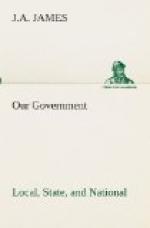[Footnote 60: Exceptions to this statement must be made to cover certain lands reserved by some of the original States that ceded their claims to the United States; as, for instance, the Western Reserve in Ohio retained by Connecticut, and other lands in the same State retained by Virginia.]
At present the larger part of the public lands of the United States are arid; that is, they cannot be cultivated without irrigation. By a law of 1902, the proceeds received from the sale of public lands in certain Western States and Territories will be expended by the National government in the construction of irrigation works. This law is destined to have a great influence upon the future of our Western States.
[Illustration]
The National System of Survey.—In the thirteen original States there was no uniform system of land survey, but each tract of land was surveyed as necessity required, generally after settlement had been made upon it. The tracts were of very irregular shapes. The boundary lines, usually starting from some natural object, were measured by rods or chains, running in certain directions as ascertained by the use of the compass. This method of survey is still in use in the Eastern States. According to a law of 1785, a uniform system of “rectangular survey” was applied to all lands belonging to the United States. This survey has preceded settlers, and has to some extent influenced the method of settlement and the nature of local government throughout the West. The lands surveyed have been divided into townships six miles square. For the boundaries of townships the law requires the use of north-and-south and east-and-west lines. To secure starting points from which to run these lines, it was necessary to designate certain meridians as Principal Meridians and certain parallels as Base Lines.
Method of Land Description.—The map indicates the location of Principal Meridians and Base Lines in the States north of the Ohio River. Starting, then, from any Principal Meridian, the tier of townships directly east is called Range I; the other ranges are numbered east and west of that meridian. Counting also from the Base Line, the townships are numbered 1, 2, 3, etc., both north and south. It thus becomes possible to locate precisely any particular township by a simple description: e.g., township 5 north, Range VIII east of the first Principal Meridian.
Since the eastern and western boundaries of townships are meridians, they approach nearer to each other as they go farther north. Hence the townships become less than six miles from east to west as the survey proceeds northward from any base line. This necessitates the running of standard parallel lines, or correction lines, at frequent intervals, to be used as new base lines (Figure 1).
[Illustration: Figure 1]
To still further facilitate the sale and description of lands, the law provides for exact methods of subdividing the township into sections, one mile square, numbered as in Figure 2.




